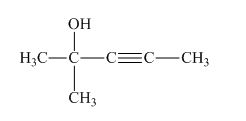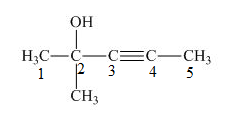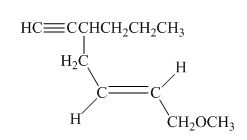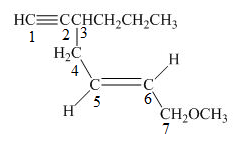
Concept explainers
(a)
Interpretation:
The substitutive name and common name of
Concept introduction:
The systematic naming of organic compound is given by
Rules for writing IUPAC name from the structural formula are given below.
- First, identify the longest carbon chain.
- The next step is to identify the groups attached to the longest chain.
- Identify the position, location, and a number of the substituents bonded to the carbon chain.
- Use prefix di, tri, tetra if the same type of substituents is present.
- Name the substituents in alphabetical order.
Answer to Problem 14.3P
The common name of the compound
Explanation of Solution
The compound
The compound
The number on the carbon atoms in the compound is shown below.
The compound is
The common name of the compound
(b)
Interpretation:
The substitutive name and common name of
Concept introduction:
The systematic naming of organic compound is given by IUPAC nomenclature. The naming of organic compound is done such that the structure of the organic compound is correctly interpreted from the name.
Rules for writing IUPAC name from the structural formula are given below.
- First, identify the longest carbon chain.
- The next step is to identify the groups attached to the longest chain.
- Identify the position, location, and a number of the substituents bonded to the carbon chain.
- Use prefix di, tri, tetra if the same type of substituents is present.
- Name the substituents in alphabetical order.
Answer to Problem 14.3P
The common name of the compound
Explanation of Solution
The compound
The compound
The number on the carbon atoms in the compound is shown below.
The compound is alkyne. Therefore, -yne will be present as the suffix. The triple bond is present on the fifth carbon atom. The compound has ten-carbon atom long chain. Therefore, the substitutive name of the compound is
The common name of the compound
(c)
Interpretation:
The substitutive name of compound is to be stated.
Concept introduction:
The systematic naming of organic compound is given by IUPAC nomenclature. The naming of organic compound is done such that the structure of the organic compound is correctly interpreted from the name.
Rules for writing IUPAC name from the structural formula are given below.
- First, identify the longest carbon chain.
- The next step is to identify the groups attached to the longest chain.
- Identify the position, location, and a number of the substituents bonded to the carbon chain.
- Use prefix di, tri, tetra if the same type of substituents is present.
- Name the substituents in alphabetical order.
Answer to Problem 14.3P
The substitutive name of the given compound is
Explanation of Solution
The structure of the given compound is shown below.

Figure 1
The compound has five carbon atom in the longest chain. Therefore, pent- will be used in the root name. The number of the carbon atoms will be started from the carbon atom which gives the lowest number to hydroxyl group in the chain.
The number on the carbon atoms in the compound is shown below.

Figure 2
The compound has methyl group and hydroxyl group. Therefore, -yne will be present as primary suffix and –ol will be present on as secondary suffix. The methyl group is resent at the second carbon. Therefore, methyl will be used as prefix. The triple bond is present on the third carbon atom and hydroxyl group is present on the second carbon atom. Therefore, the substitutive name of the compound is
The substitutive name of the given compound is
(d)
Interpretation:
The substitutive name of compound is to be stated.
Concept introduction:
The systematic naming of organic compound is given by IUPAC nomenclature. The naming of organic compound is done such that the structure of the organic compound is correctly interpreted from the name.
Rules for writing IUPAC name from the structural formula are given below.
- First, identify the longest carbon chain.
- The next step is to identify the groups attached to the longest chain.
- Identify the position, location, and a number of the substituents bonded to the carbon chain.
- Use prefix di, tri, tetra if the same type of substituents is present.
- Name the substituents in alphabetical order.
Answer to Problem 14.3P
The substitutive name of the compound is
Explanation of Solution
The structure of the given compound is shown below.

Figure 3
The compound has seven carbon atom in the longest chain. Therefore, hept- will be used in root name. The number of the carbon atoms will be started from the carbon atom which gives lowest number to propyl group in the chain.
The number on the carbon atoms in the compound is shown below.

Figure 4
The compound has propyl group and methoxy group. Therefore, methoxy and propyl will be present as suffix. The propyl group is present at the third carbon. The triple bond is present on the first carbon atom and double bond is present at the fifth carbon atom. Therefore, the substitutive name of the compound is
The substitutive name of the given compound is
(e)
Interpretation:
The substitutive name of compound is to be stated.
Concept introduction:
The systematic naming of organic compound is given by IUPAC nomenclature. The naming of organic compound is done such that the structure of the organic compound is correctly interpreted from the name.
Rules for writing IUPAC name from the structural formula are given below.
- First, identify the longest carbon chain.
- The next step is to identify the groups attached to the longest chain.
- Identify the position, location, and a number of the substituents bonded to the carbon chain.
- Use prefix di, tri, tetra if the same type of substituents is present.
- Name the substituents in alphabetical order.
Answer to Problem 14.3P
The substitutive name of the given compound is
Explanation of Solution
The structure of the given compound is shown below.

Figure 5
The compound has five carbon atom in the longest chain. Therefore, pent- will be used in root name. The number of the carbon atoms will be started from the carbon atom which gives lowest number to double bond in the chain.
The number on the carbon atoms in the compound is shown below.

Figure 6
The compound has hydroxyl group. Therefore, hydroxyl will be present as prefix. The hydroxyl group is present at the third carbon. The triple bond is present on the fifth carbon atom and double bond is present at the first carbon atom. Therefore, the substitutive name of the compound is
The substitutive name of the given compound is
Want to see more full solutions like this?
Chapter 14 Solutions
EBK ORGANIC CHEMISTRY STUDY GUIDE AND S
- presented by Morallen Lig Intermine the hand product for the given mution by adding atoms, bonds, nonhonding diarion panda скуль Step 3: Comp the draw the product Step 2: Agama workup Compithe 429 ملولةarrow_forwardReaction A 0,0arrow_forwardpresented by Morillon Leaning Predict the organic product for the min кусур HSC Adithane carved arnown to come than that to the condon slchroruis in acid in in aquishri with ноюarrow_forward
- 6.15PM Sun Mar 30 K Draw the major product of this reaction. Include any relevant stereochemistry. Ignore inorganic byproducts. Problem 1 of O H [PhзPCH2CH3]*C|¯ NaH Drawing > Q Atoms, Bonds and Draw or tap a nearrow_forward8:17 PM Sun Mar 30 Draw the major product of this reaction. Ignore inorganic byproducts. HSCH2CH2CH2SH, BF3 Probler Drawing Ato Bonds Clarrow_forwardpresented by Mr L How the coprion. (Il Done in no wraction, dew the starting redential) доarrow_forward
- 8:16 PM Sun Mar 30 K Draw the major product of this reaction. Ignore inorganic byproducts. Proble 1. CH3MgBr 2. H3O+ F Drawingarrow_forwardо но оarrow_forwardName the major organic product of the following action of 4-chloro-4-methyl-1-pentanol in neutral pollution 10+ Now the product. The product has a molecular formula f b. In a singly hain, the starting, material again converts into a secule with the molecular kormula CIO. but with comply Draw the major organic structure inhalationarrow_forward
- Macmillan Learning Alcohols can be oxidized by chromic acid derivatives. One such reagent is pyridinium chlorochromate, (C,H,NH*)(CICTO3), commonly known as PCC. Draw the proposed (neutral) intermediate and the organic product in the oxidation of 1-butanol by PCC when carried out in an anhydrous solvent such as CH₂C₁₂. PCC Intermediate OH CH2Cl2 Draw the intermediate. Select Draw Templates More с H Cr о Product Draw the product. Erase Select Draw Templates More H о Erasearrow_forwardIf I have 1-bromopropene, to obtain compound A, I have to add NaOH and another compound. Indicate which compound that would be. A C6H5 CH3arrow_forwardProvide the reagents for the following reactions.arrow_forward
 ChemistryChemistryISBN:9781305957404Author:Steven S. Zumdahl, Susan A. Zumdahl, Donald J. DeCostePublisher:Cengage Learning
ChemistryChemistryISBN:9781305957404Author:Steven S. Zumdahl, Susan A. Zumdahl, Donald J. DeCostePublisher:Cengage Learning ChemistryChemistryISBN:9781259911156Author:Raymond Chang Dr., Jason Overby ProfessorPublisher:McGraw-Hill Education
ChemistryChemistryISBN:9781259911156Author:Raymond Chang Dr., Jason Overby ProfessorPublisher:McGraw-Hill Education Principles of Instrumental AnalysisChemistryISBN:9781305577213Author:Douglas A. Skoog, F. James Holler, Stanley R. CrouchPublisher:Cengage Learning
Principles of Instrumental AnalysisChemistryISBN:9781305577213Author:Douglas A. Skoog, F. James Holler, Stanley R. CrouchPublisher:Cengage Learning Organic ChemistryChemistryISBN:9780078021558Author:Janice Gorzynski Smith Dr.Publisher:McGraw-Hill Education
Organic ChemistryChemistryISBN:9780078021558Author:Janice Gorzynski Smith Dr.Publisher:McGraw-Hill Education Chemistry: Principles and ReactionsChemistryISBN:9781305079373Author:William L. Masterton, Cecile N. HurleyPublisher:Cengage Learning
Chemistry: Principles and ReactionsChemistryISBN:9781305079373Author:William L. Masterton, Cecile N. HurleyPublisher:Cengage Learning Elementary Principles of Chemical Processes, Bind...ChemistryISBN:9781118431221Author:Richard M. Felder, Ronald W. Rousseau, Lisa G. BullardPublisher:WILEY
Elementary Principles of Chemical Processes, Bind...ChemistryISBN:9781118431221Author:Richard M. Felder, Ronald W. Rousseau, Lisa G. BullardPublisher:WILEY





